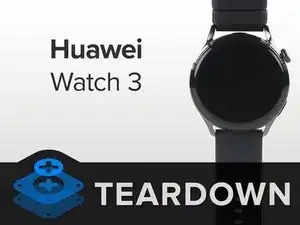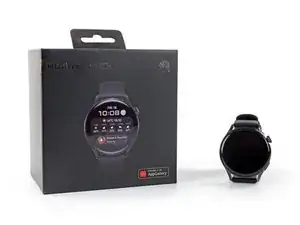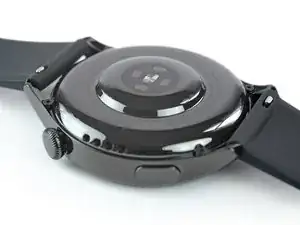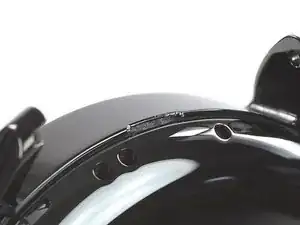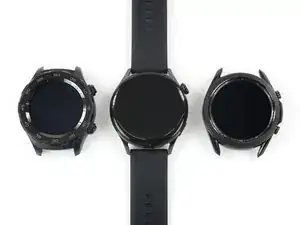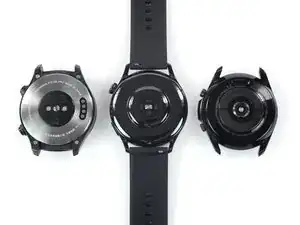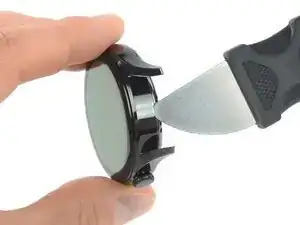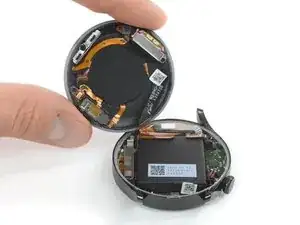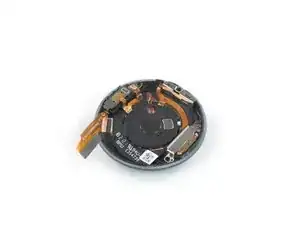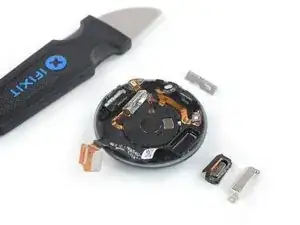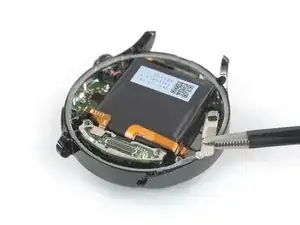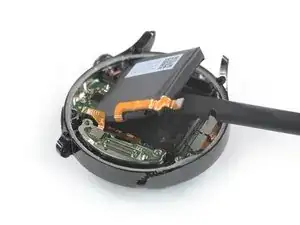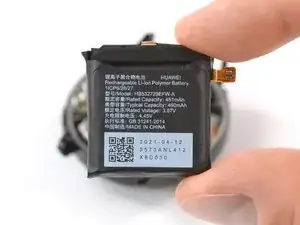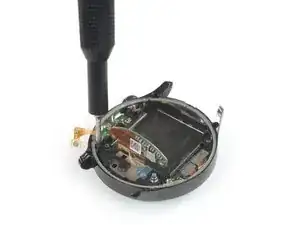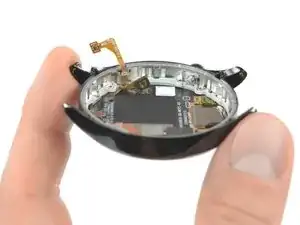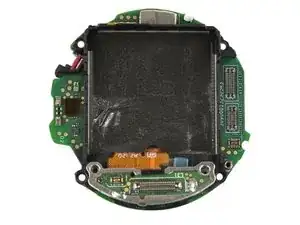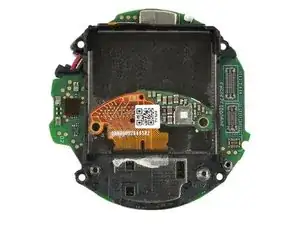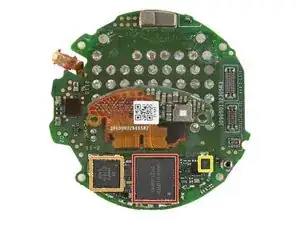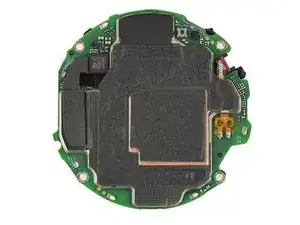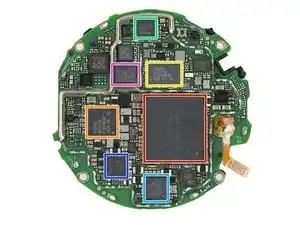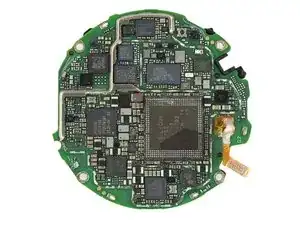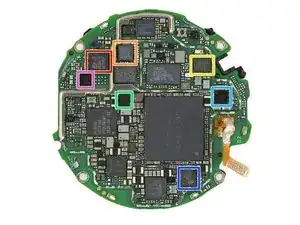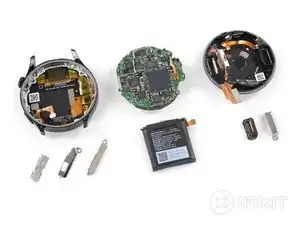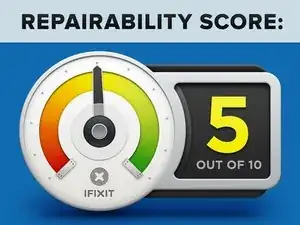Introduction
The new Huawei Watch 3 is here and makes a quick stop on our teardown table, where we wait with our shiniest tools. Let’s see how much need for harmony (on a mechanical level) there is. Time for a teardown!
Want to spend an afternoon browsing the latest teardowns? Follow us on Twitter, Instagram, and Facebook. For iFixit delivered, check out our newsletter.
Tools
-
-
Before we dive in, let's judge this book by its cover just a little:
-
1.43 inch circular AMOLED touch display with 466 x 466 pixels (326 ppi) and a 60 Hz refresh rate
-
2 GB RAM and 16 GB internal storage
-
Updated sensor array with newly included temperature sensor
-
10 W wireless charging
-
5 ATM water resistance (50 meters)
-
So far so good—let's dig deeper!
-
-
-
Looking at this huge box, we'd expect the Huawei Watch 3 to be a little bit bigger—or at least to find a couple more watches.
-
This model goes by the the name GLL-AL04 and sports a digital crown and a side button.
-
On the rear we can already spot four screws securing the back cover (a good sign!) but the tiny notch behind the top band indicates a slightly more... complex opening procedure.
-
-
-
The Watch 3 has some stiff competition. From left to right: Huawei Watch 2, Huawei Watch 3, and the Galaxy Watch3.
-
We see an increased display size compared to its predecessor, courtesy of the smaller bezel.
-
Where the Galaxy Watch3 puts that bezel to work navigating menus and scrolling, the Huawei Watch 3 delegates those tasks to its digital crown.
-
On the back, we see Huawei doubled down on the optical sensors—and switched to wireless charging, as the contact pads of yesteryear are no more.
-
-
-
With the four rear Torx screws out of the way we'd hoped to get in with just an opening tool, but this year's Huawei timepiece needs a little more force.
-
Some heat and a Jimmy finally crack our clam open to reveal adhesive instead of a repair-friendly rubber gasket keeping the watch watertight.
-
Moving that cable out of harm's way and opting for a reusable rubber gasket would simplify the procedure.
-
-
-
After popping the watch open, the Jimmy returns for some more heavy-duty prying.
-
Most of the components in the sensor assembly are held in place by Phillips screws or brackets, and a couple rivets. Riveting! Regardless of fastener, the components are stuck on non-removable flex cables, hampering repairs. Not to mention the sensor array itself which is heavily secured to the back cover.
-
All our hard work yields only one replaceable part on the back cover—the loudspeaker. At least we got something.
-
-
-
With one more small bracket out of the way we have full access to the battery. A little spudgering here, a little sputtering there, and the battery's free from its adhesive.
-
This powerhouse is rated at 1.78 Wh (460 mAh @ 3.87 V) and is supposed to offer you 3 days of fun with your smartwatch—or up to 14 in "ultra-long battery life mode!"
-
The battery, like many others, uses a classic soft-shell design. It makes us wonder why Apple seems to be the only manufacturer experimenting with metal pouch batteries.
-
-
-
The motherboard finally grants us a break from prying—a Phillips driver is all we need to free this board.
-
Motherboard out of the way, we turn to the 1.43-inch AMOLED screen and it's back to adhesive. That display is firmly adhered.
-
Since this watch is already in its third generation with a variety of offshoots, we'd hope for a more repair-friendly solution by now. Maybe Huawei could take a page from Samsung's Galaxy Watch book?
-
-
-
With the motherboard out, we find the bottom of it rather… unspectacular at first sight. A big battery recess and all of the cable connectors set up camp here, but deeper down we spot some hidden chips:
-
CMJRD11G04G 16 GB NAND flash storage (likely) layered above maybe a WiFi processor
-
Ambiq Micro AMAP42 Apollo4 SoC
-
Runic RS7222 USB 2.0 DPDT analog switch (likely)
-
We're not in the mood to camp here with them for long, so we hurry over to more important sightseeing. Onward!
-
-
-
The top of the motherboard offers the following important-looking silicon:
-
GF2EE1-16G-X 2 GB SDRAM (likely) with a HiSilicon Hi6262 Kirin 710 layered underneath
-
HiSilicon Hi6556 GFCV100 Power IC
-
HiSilicon Hi6D05 Power Amplifier Module
-
Airoha AG3335SD RFSoC GPS receiver
-
HiSilicon Hi1132—which is basically the Kirin A1 (running an ARM Cortex-M7 SoC) w/ Bluetooth controller
-
Texas Instruments BQ25601 Single Cell Battery Charger
-
HiSilicon Hi6353 RF transceiver (likely)
-
-
-
Smaller (and still important!) bits and pieces:
-
STMicroelectronics 54HJJ9 NFC controller
-
HiSilicon 6H03S LNA/RF switch (likely)
-
85G1 AAAC, likely an antenna switch module
-
HiSilicon 656211 power management IC
-
Cirrus Logic 35L36A audio amplifier
-
X-Powers AC107 2-channel audio capture A/D converter
-
Omnivision Group (formerly Will Semiconductor) WAS4646C 2:1 SPDT analog switch
-
-
-
With that, the Huawei Watch 3's time with us is over. All these glued and connected parts means we're left with a lot of big pieces, but at least the battery—which is guaranteed to eventually fail—is out of the watch.
-
Unfortunately we don't see that much evolution repair-wise from this series. Quite the opposite: more components crammed in and fewer that are independently replaceable.
-
-
-
The Huawei Watch 3 earns a 5 out of 10 on our repairability scale (10 is the easiest to repair):
-
Only press fit connectors are used with no overlapping cables.
-
Once the watch is open, the battery is easy to access and replace.
-
Opening the watch is doable, but not easy, due to the back cover's tight fit and use of adhesive instead of gaskets.
-
The only separately-accessible part on the back cover (the loudspeaker) requires some digging, and is glued into a tight recess.
-
A broken display requires replacing the main watch case which houses the screen.
-
The back cover and attached sensors requires a complete replacement if any of its components fails.
-
2 comments
When a tiny smartwatch has as much RAM and more storage than the Android tablet you use every day.
Bnas noches nesecito reparar mi reloj inteligente hawei was 3 tiene dañada la rueda lateral como puedo hacer
